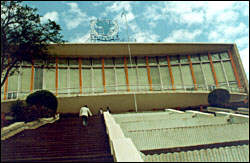 THE DEVELOPMENT ENVIRONMENT IN ETHIOPIA THE DEVELOPMENT ENVIRONMENT IN ETHIOPIA |
Ethiopia's history records that prior to 1991, it experienced centralized regimes of one form or another that suppressed the participation of the people in issues of self-governance and development. Over the last two decades, i.e. during the 'derg' regime, the economy was governed by inappropriate policies in that the highly centralized state had rigid control over the economy. This severely restricted private ownership and investment in all spheres of economic and social activities.

| With the collapse of the 'derg' regime in May 1991, the political system in Ethiopia took a dramatic turn and formed a multiparty-based transitional charter, moved towards a market-oriented economy. This culminated in the establishment, through general elections, of the Federal Democratic Republic of Ethiopia in 1995.
The current administrative system of the country, though quite young, has therefore created a relatively conducive atmosphere for the country's future development though much remains to be done to improve the atmosphere, according to local and foreign investors (and IMF reports), in the areas of private ownership of land, financial markets, etc.
 Population Population |
Ethiopia is the second most densely populated country in Sub-Saharan Africa. With a growth rate close to 3 per cent per annum, the population of the country as of July 1 1998 was around 60 million, of which half are women and 8.7 million or about 14 per cent reside in urban areas (see Table 5). It has been projected that in less than a quarter of a century the population will climb the 100 million mark. |

